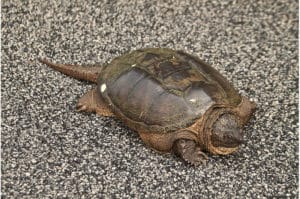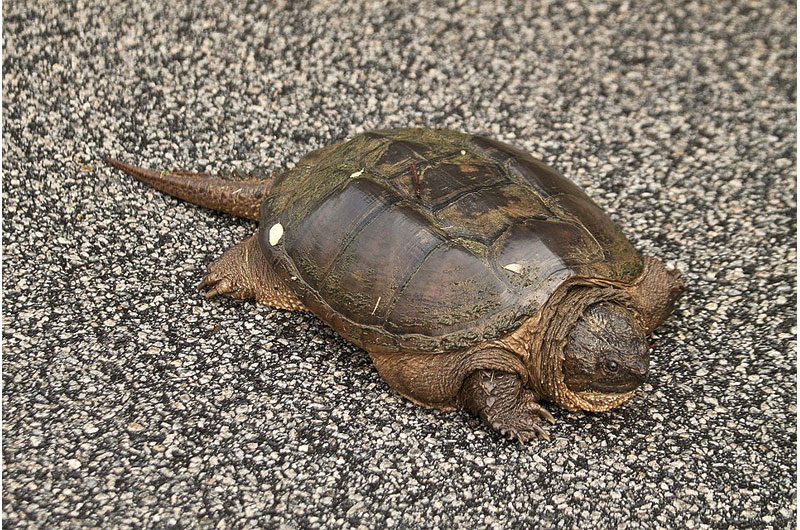Dr. Sarah Treanor Bois
Director of Research & Education at the Linda Loring Nature Foundation
As we start to get outside in the warm spring weather, we may be noticing more signs of the wildlife around us: a few deer tracks here, some rabbit scat there, a tent caterpillar tent among the trees, as well as a bird nest or two in the shrubs or the top of an outdoor shower.
But what should we do when we see an animal in distress? According to the U.S. Fish and Wildlife Service, “The best way to help a wild animal is to leave it alone.” Most animals do not need or want your help. Many wild animals want nothing to do with humans. They do anything they can to get away (including biting and fighting). If an animal is truly in distress, then trying to “help” may cause undo stress to the creature. Many times, this stress can make matters worse.
BABY BIRDS
Spring is breeding season for many species, but we people seem to have the most interactions with birds this time of year. This is possibly due to many more nests in our own yards. Birds in our region make all kinds of nests of many different shapes, sizes, and materials. No matter the location or nesting material, nests mean eggs and ultimately baby birds. So, if you find a nest, what do you do? Here are a few things to keep in mind:
- Do not touch or get too close! A spring nest is likely an active nest. Parent birds do not need you checking on their nest or stressing them out while they gather nesting material and food. They’re soon going to be new parents; there’s enough to worry about!
- Do not remove nests from their location. Most of the birds we encounter on Nantucket are protected under the Migratory Bird Act of 1918. It is illegal to take and possess eggs, nests, and bird parts (including feathers) without a federal permit.
“But what if I find a baby bird on the ground?” - Many bird species such as robins, jays, crows, and owls leave the nest and spend as many as 2-5 days on the ground before they can fly. This is a normal and vital part of the young birds’ development. While they are on the ground, the birds are cared for and protected by their parents and are taught vital life skills (finding food, identifying predators, flying).
- Do not pick up the bird! Taking these birds into captivity denies them the opportunity to learn skills they need to survive in the wild. Unless a bird is injured, it is essential to leave them outside to learn from their parents.
- If you are concerned that a bird fell from its nest too early, you may try and return the bird to its nest. If the nest has been destroyed or is unreachable, you may substitute a small box lined with tissue and suspend it from a branch near to where you believe its nest is located.
- Birds have a poor sense of smell and very strong parental instincts, which means they will usually continue caring for their young. Raising wild birds in captivity is always a last resort.
Although it may seem “safer” to raise young birds in captivity, birds (and other wild animals) raised without the benefit of learning from their parents only have a minimal chance of survival when released.
REPTILES IN THE ROAD
Why did the turtle cross the road? Because she had somewhere to be! Spring is also known as “turtle 
If you see a turtle on the road, here are a few tips essential for turtle safety (and your safety):
- First up: slow down, stop, and let it pass. If it is stopped or if you think you can SAFELY move the turtle, follow the directions below.
- If moving a turtle, always bring it to the road edge in the direction it was headed. If you don’t s/he will likely try to cross the road again. (Turtles have places to go, too!) • Never pick up a turtle by the tail. You can permanently damage their vertebrae.
- Even if snapping turtles look old and slow, they can move fast and are likely to bite because they feel threatened. If you have a shovel or a broom in your car, you can help them scoot across the road.
The warm, black pavement of many roads can also be a perfect spot for a basking snake. These cold-blooded creatures need the sun’s rays to warm their bodies. This is especially true in the spring as they become more active after the dormant winter. Be on the lookout for snakes on the road. And, please, don’t try and run them over! We love our Nantucket native snakes. As a reminder: none of them are venomous.
If you see a snake on the road, slow down, stop, and let it pass. You can also try and get it to cross by giving it a little nudge, if possible. Just seeing your shadow will sometimes entice a snake to move on.
INJURED WILDLIFE
If you see an injured animal, the best thing to do is to call the Environmental Police Officer on Nantucket. IMPORTANT: before you “rescue” any wildlife, be sure it actually needs your help. If you find an animal in distress and you’re sure it needs help, call the Nantucket Environmental Police Officer (EPO) (508-257-6932). The EPO is also our game warden and has the knowledge of wildlife and the training to know what to do. When you call the EPO, be ready with information such as where the animal is, what kind of animal it is, and any other facts. Be sure to accurately describe what you see and not what you think is happening. You can also try the non-emergency police line to reach the animal control officer 508-228-1212.
We do not have any licensed wildlife rehabilitators on-island, which makes rescue of many injured species difficult if not impossible, though sometimes animals are transported off-island.
Many baby animals are left alone all day long, relying on camouflage for protection. Removing them from their hiding spots may mean they are vulnerable to predators and their parents won’t be able to find them.
To learn more about the wildlife found on Nantucket, try a bird or nature walk. The Linda Loring Nature Foundation has walk opportunities with experienced staff throughout the year (llnf.org); in-season, The Maria Mitchell Association (mariamitchell.org) also offers nature walks and marine life expeditions. The Maria Mitchell Association Natural Science Museum opens in June and has both live and stuffed examples of Nantucket fauna.



